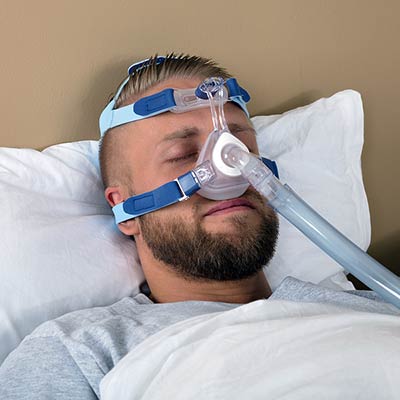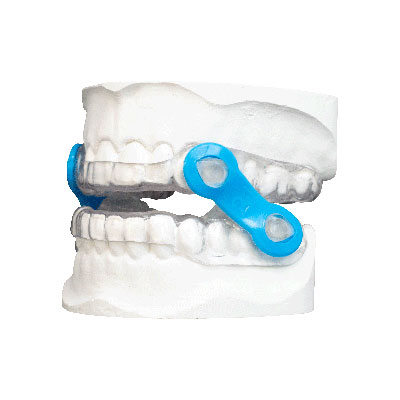
What is CPAP?
CPAP (Continuous Positive Airway Pressure) therapy is considered a treatment standard for Obstructive Sleep Apnea (OSA), a condition that causes the body to stop breathing (an apnea ‘episode’) repeatedly during sleep.
For an OSA patient, the apnea episode occurs when the soft tissue lining within the upper airway becomes overly relaxed during sleep; the tissue sags and collapses, blocking the flow of air into the body and causing breathing to stop.

How does CPAP work?
CPAP is a medical device that an OSA patient uses during sleep to prevent airway collapse and maintain consistent breathing. CPAP is prescribed for the OSA patient by their sleep physician.
The CPAP device consists of a nose mask that is connected by a hose to a small machine that produces a steady flow of slightly pressurized air that the patient breathes in while sleeping. The level of air pressure is set to treat the patient's sleep apnea diagnosis (mild, moderate or severe). The steady stream of air pressure helps support the airway walls and soft tissue to prevent blockage during sleep.
What is CPAP Intolerance?
CPAP intolerance is the inability for a patient to use CPAP for treatment of sleep apnea. CPAP intolerance can occur for a number of reasons, ranging from physical side effects to frustration with managing the equipment.
Commonly reported CPAP problems include:
- Feeling claustrophobic or constrained while wearing the mask and being ‘tethered’ to the CPAP machine
- Dry nasal passages, dry mouth, nasal congestion or nose bleeds
- Dizziness or morning headaches
- Difficulty breathing normally or burning sensation in lungs during use
- Gas and bloating from swallowing pressurized air
- Facial skin irritations and blemishes from wearing mask
- Inconvenience of cleaning equipment
- Respiratory infections when equipment is not cleaned regularly
Some patients become discouraged with CPAP and abandon treatment altogether, which increases the risk of serious sleep-disorder related illnesses. Obstructive sleep apnea is a dangerous health condition that will not get better without intervention and treatment.
Alternative Treatments to CPAP Therapy
If a patient is unable to tolerate CPAP, the sleep specialist will discuss alternative treatment solutions to manage their obstructive sleep apnea. A sleep physician may recommend a combination of these treatment options as alternatives to CPAP therapy for treatment of obstructive sleep apnea:
Oral Appliance Therapy (OAT) for Obstructive Sleep Apnea

Image courtesy of True Function Laboratory
For obstructive sleep apnea patients that are not able to tolerate CPAP due to other illness or discomfort with the equipment, the sleep physician may recommend oral appliance therapy as an alternative. An OSA oral sleep appliance is designed to be worn during sleep to maintain the lower jaw in a forward position, which helps to keep the airway open to prevent apnea episodes.
The sleep specialist refers the OSA patient to Macon sleep dentist Dr. Leigh Bennett to design and manage the oral sleep appliance as part of their treatment plan. Dr. Bennett has extensive training in dental appliance therapy for sleep-disordered breathing and TMJ disorders.
Oral appliances used for treatment of obstructive sleep apnea resemble a dental mouthguard or nightguard. Made of sturdy dental acrylic materials, the removable appliance is worn over the upper and lower teeth while sleeping.
Oral appliance therapy may also be used in conjunction with CPAP for patients that can use CPAP successfully. Learn more about Oral Appliance Therapy.
Lifestyle Changes and Weight Loss
Smoking and Obstructive Sleep Apnea
It is no surprise that smoking is an irritant to the airway that can lead to inflammation and contribute to obstructive sleep apnea. Quitting smoking has many health benefits; we encourage our patients to ask us about resources to help with quitting smoking for good.
OSA Patients and Alcohol Use
Drinking alcohol can make the body overly relaxed during sleep, which can lead to the triggering cause of obstructive sleep apnea: loose, floppy soft tissue structures in the upper airway. Alcohol also slows the body’s response systems; it takes longer for an intoxicated sleep apnea patient to wake up after breathing has stopped. This can potentially extend the amount of time that an obstructive sleep apnea patient is not breathing, increasing level of harm to the body. OSA patients are encouraged to limit alcohol use, especially before bedtime.
Healthy Weight for Healthy Sleep
Obesity and being overweight is a common underlying factor for obstructive sleep apnea patients. Losing excess weight eases the burden of tissue and fat around the upper back on the airway, reducing the risk of the airway being compressed by excess weight as the body relaxes during sleep. A regular exercise routine also helps with maintaining muscle tone and weight management for breathing health.
Positional Therapy for Obstructive Sleep Apnea Patients
For some OSA patients, sleeping on their back, combined with basic gravity, can cause the airway tissues to drop and the tongue to fall backwards, leading to an apneic event. The sleep physician may recommend that the patient sleep on their side to prevent this from happening.
Some patients find that wearing a backpack with tennis balls, or a device that is worn around the waist that vibrates when the patient rolls onto their back can be helpful to nudge them into a better sleep position without waking them up completely.
Sinus Decongestant Medications
Over the counter sinus decongestants are not, on their own, a treatment for obstructive sleep apnea. Some sleep physicians may recommend that patients with seasonal allergies take decongestant medication in conjunction with other treatments for OSA to help reduce irritation of nasal passages.
Surgery for Obstructive Sleep Apnea
There are cases of obstructive sleep apnea that may respond to surgical removal of tonsils, adenoids or small sections of soft tissue in the throat and upper airway, including from the uvula (small ‘hanging’ tissue in the back of the throat), soft palate or even the tongue. Surgical treatment is weighed carefully by the sleep specialist; generally, non-surgical options are preferred for treatment of obstructive sleep apnea.
Know Your Options and Alternatives for Treatment of Obstructive Sleep Apnea
The first step to treating chronic, loud snoring and gasping for air during sleep is to have a thorough evaluation and diagnosis from a medical sleep professional. If you are diagnosed with obstructive sleep apnea, your physician will guide you through treatment options, along with pros and cons of each approach.
If you have questions about the diagnosis or treatment of obstructive sleep apnea, we encourage you to contact your physician or contact our Macon TMJ & dental sleep center for a sleep specialist referral.